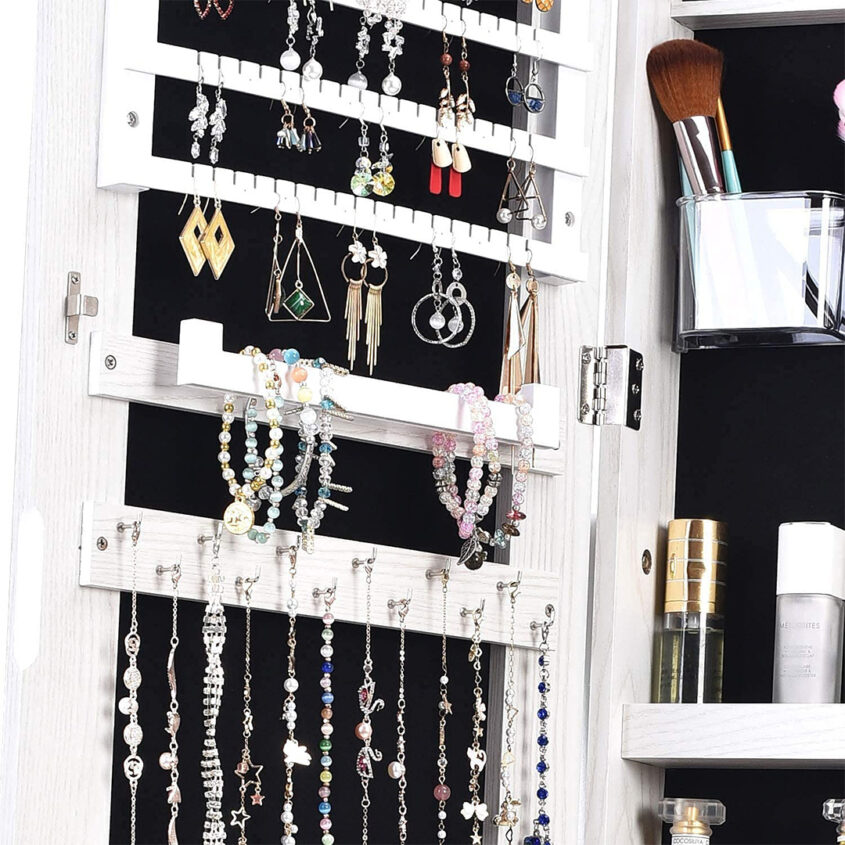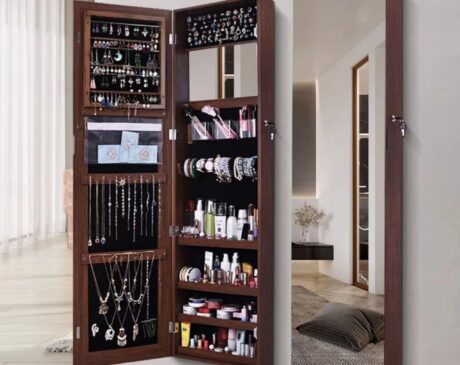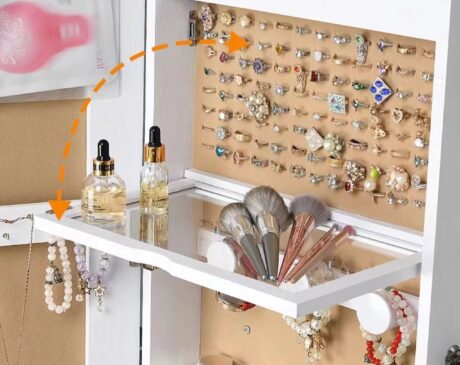How do you organize a jewelry armoire?

Organizing a jewelry cabinet is both an art and a science. With the right approach, you can transform a chaotic jewelry collection into a neatly organized showcase that makes accessorizing a breeze. Let’s dive into creating a system that combines aesthetic appeal with practical functionality.
Introduction to Jewelry Cabinet Organization
Jewelry cabinets are not only functional furniture but also practical. They are the sanctuary where we store our most precious decorative items. The way we organize them can greatly affect our daily lives and the longevity of our jewelry. An organized closet not only adds to the beauty of your space, but also saves you valuable time when getting ready.
Understanding the importance of an organized closet
An organized jewelry closet does more than just beautifully display your collection. It helps prevent damage, loss, and wear and tear caused by improper storage. Tangles, loss of luster, and scratches are common problems that proper organization can address, thus maintaining the luster and integrity of your jewelry for years to come.
Types of Jewelry Cabinets Available
Choosing the right type of jewelry cabinet is fundamental to achieving organizational success. There is an abundance of choices on the market: elegant vertical armoires, practical door-over-door armoires, or space-saving wall-mounted armoires. Each type has its own set of features for different collections and living spaces.
A step-by-step guide to organizing your jewelry closet
Transitioning to an organized closet is a process. Here’s how to approach it in an organized way:
Step 1: Empty and clean your closet
Start with a blank canvas. Completely empty your closet and give it a thorough cleaning. Use a mild detergent and a soft cloth to avoid damaging any delicate surfaces. This step ensures that your jewelry has a clean and dust-free home.
Step 2: Sort Your Jewelry
Organizations thrive on categorization. Sort your jewelry into logical categories: earrings, necklaces, bracelets, watches, and rings. By doing this, you create an intuitive system in which each section has a place.
Types of Jewelry
Within these broad categories, consider organizing them further by occasion or style, such as everyday wear, formal events, or vintage collections. This nuanced approach can make access and decision-making easier.
Step 3: Implement a storage solution
An organized closet is a study in efficient space utilization. Explore a variety of storage solutions that can protect and display your jewelry, pairing each piece in its proper place.
Creative Organizing Tips
Unleash your creativity with unconventional organizing tools. Repurpose household items like small plates, felt-lined trays and even hook boards to keep each piece of jewelry visible and tangle-free.
Step 4: Arrange Jewelry by Frequency of Use
Strategically place the most frequently used pieces in prime locations. If you wear certain items daily, they should be the most accessible, while special occasion jewelry can be stored further back or in less accessible areas.
Step 5: Keep Your Closet Organized
Maintaining an organizational system is just as important as creating one. Take the time each month to reassess and reorganize your closet. This regular maintenance will prevent falling back into disorganization.
Additional Tips and Tricks
Here are some further insights to refine your jewelry organization:
Tip 1: Use dividers and containers
Use dividers, small boxes and bags to separate single pieces or sets of items. This prevents scratches and allows you to find the right pieces quickly and easily.
Tip 2: Protect delicate items
Extra care should be taken with delicate items. Use soft fabrics to wrap and cushion fragile jewelry and store them in a designated area of your closet.
Tip 3: Incorporate Visual Labels
Labels can be used as a visual aid to maintain order. They are especially useful if you have a large collection or items stored out of sight.
Common Mistakes to Avoid
Even the most well-intentioned organizations can falter if common mistakes are made:
Mistake #1: Overfilling compartments
Resist the urge to overfill. Overcrowding can lead to tangled chains and damaged items. Each piece should have enough room to lay flat or hang freely.
Mistake #2: Neglecting to Sort by Size and Length
When organizing, pay attention to the size and length of your items. Longer necklaces should have enough room to hang without touching the bottom of the closet, and smaller necklaces should be easy to reach without being overshadowed by larger ones.
Mistake #3: Forgetting to clean regularly
Don’t let your organizational efforts go to waste. Set a schedule for regular closet checks to make sure everything is in place and well-maintained. This habit will also help you re-familiarize yourself with forgotten pieces and may inspire new outfit combinations.
An organized jewelry closet not only simplifies your daily life, it also brings harmony to your space. It honors the pieces that bring beauty to your life and makes choosing the perfect accessory for any occasion a pleasure, not a chore. Remember, the key to keeping your closet organized is to make sure each piece of jewelry has its own place in your collection. With the right approach and regular maintenance, your closet can serve not only as a storage solution, but also as a showcase for your personal style and cherished memories.
Frequently Asked Questions
1. How often should I clean out my jewelry closet?
Ideally, you should thoroughly clean out your jewelry closet every six months. However, it is helpful to do a quick check once a month to make sure everything is in place and to wipe off any dust.
2. What is the best way to store silver jewelry to prevent tarnishing?
Silver jewelry is best stored in airtight containers with tarnish strips. Storing silver jewelry in small individual zipper lock bags will also prevent tarnishing.
3. Can I store faux jewelry in the same closet as fine jewelry?
Yes, you can store faux jewelry in the same closet as fine jewelry, but it is wise to store them in separate sections or drawers to prevent any potential scratches or chemical reactions between the different metals and materials.
4. What should I do with jewelry that is broken or no longer worn?
If a piece is broken but has sentimental value, consider having it restored. If you no longer wear certain pieces, you can repurpose them, donate them to charity, or even sell them if they have value.
5. How can I maximize the space in my small jewelry closet?
Making the most of your small closet space involves creatively designing storage solutions that utilize vertical space for hanging items, as well as stackable trays for rings and earrings. It’s also about being selective and keeping only the clothes you actually wear.




